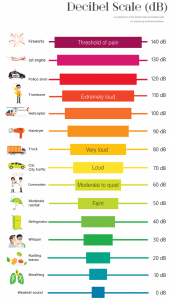Here’s some sound advice about noise and protecting
your hearing.
Posted October 21, 2020
October is National Protect Your Hearing Month, and SynTerra professionals want to raise awareness about the hazards of excessive noise exposure and how to keep your hearing healthy.
Many people associate hearing loss with aging, but hearing loss can also be caused by exposure to loud noise. In some cases, hearing loss can be prevented with the right knowledge and training. Therefore, it is important to learn how noise affects hearing and practice hearing loss prevention techniques as early and often as possible.
Noise is any unwanted sound that is considered unpleasant, loud, or disruptive to hearing. It can be as soft as a ticking clock or as loud as a plane taking off. Sound is measured in decibels (dBs). A decibel (in the acoustic world) is a unit of measurement used to express sound-power or loudness.

Common noises (measured in dBs) are shown above.
Hearing loss tends to be associated with work environments, but many things at home can cause immediate or long-term damage. So, a simple way to think about whether you, a coworker, or family member might have hearing damage is to ask, “Do you ask others to speak up so that you can hear them?” or “Do others ask you to speak more softly to them?” Both of these are easy ways to start thinking about hearing loss.
Hearing loss is preventable; however, severe hearing loss can be irreversible. Exposure to excessive noise can result in temporary hearing loss, where hearing will return when the noise goes away. But some noise or long-term exposure to excessive noise can lead to permanent loss.
Avoiding the dangers of excessive or long-term noise exposure
The first and simplest way to avoid the dangers of noise exposure is to distance yourself from the source of the noise. Examples of this method include standing at the back of a crowd at the racetrack or shutting your office door to prevent noise from industrial machines in your building from getting to your ears.
A second way to avoid exposure is to use personal protective equipment (PPE). These devices, which can be purchased at general supply stores, come in a range of options to suit your requirements. Common examples of hearing protection are earplugs and earmuffs. All types have advantages and disadvantages, depending on the person using them and the type of work being done.
The effectiveness of hearing protection is expressed by the Noise Reduction Rating (NRR). The ratings can be found on the PPE packaging. The higher the NRR, the more effective the device is in protecting your hearing. To calculate the specific NRR of an item, a useful tool can be found here.
The best way to monitor yourself or someone you know is to have regular audiometric examinations. The examination is done in a controlled environment by a healthcare professional. The first exam determines the baseline of hearing. Regular (annual) exams thereafter monitor hearing over time and determine if your hearing is being affected throughout your lifetime or career. Also, knowing how organizations like OSHA have determined safe levels of noise exposure can help in creating a safer home or work environment.
If you need assistance with noise evaluations, hearing conservation programs, or PPE selection, at your workplace, please contact Paul Tarquinio at ptarquinio@synterracorp.com.





